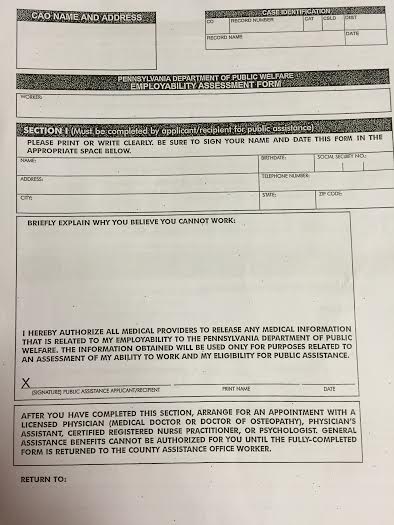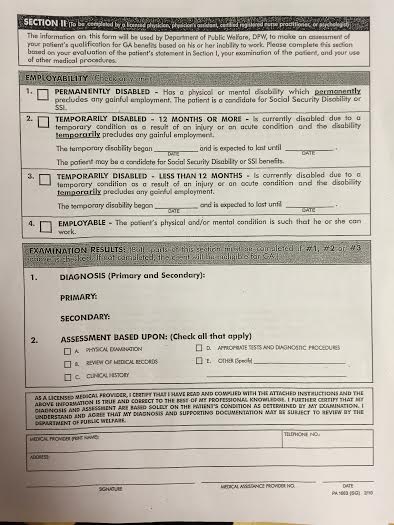This story revolves around a single piece of paper. Among those who use this piece of paper, and among those who benefit from it, there exists much confusion about the paper’s intention. Some of the providers suspect intentional misguidance by those who designed the form. Take a glance at this form, titled the “Employability Assessment Form,” and guess its intention. After reading the headings of the sections, you should be able to say, “This form is for…”
You may have guessed that the Employability Assessment Form involves either getting a job or getting some type of unemployment benefit. In fact, it has no bearing on either. Instead, this form qualifies an individual for health insurance. To be eligible to receive combined federal and state Medicaid using this form, the patient must first fall below the established poverty line and not already have a permanent disability. After these qualifications are met, they must then be deemed unemployable by a health care professional in order to acquire health insurance.
Prevention Point, a clinic located in North East Philadelphia, utilizes this form. According to clinic coordinator Clayton Ruley, the clinic can best be described as “a social services emergency department.” I sat down with Ruley to discuss the form and to better understand why some feel it to be misleading.
Ruley explained that the form represents a greater issue for the vulnerable population that frequents the clinic, which also doubles as one of only two needle distributors in Pennsylvania. As a medical student, I was privileged enough to meet some of these disadvantaged patients at the clinic and even help them fill out the form. Ruley says that some physicians are reluctant to fill out the form because of what they think it represents. The patients “know that [in response to] the title, Employability Assessment Form, a doctor will say ‘I don’t want to be the difference between someone being deemed employable or not employable.'”
Upon further evaluation, I learned that rather than simply being a badly worded medical form, the Employment Assessment Form represents a fundamental disagreement between policy makers and many health care and social workers. The policy makers who developed the form in Pennsylvania imply that people who can work and do not have disability should be able to afford and therefore buy their own insurance (or have it provided by an employer). If however, a person has a qualifying medical diagnosis, he or she is now exempt from the expectation of being able to find a job and pay for his or her own insurance. This approach clearly contains holes and gaps, with a significant population, the unemployed and healthy, unable to qualify for government aid to buy health insurance. “You shouldn’t have to have a disease to get health insurance … It’s a universal belief of Prevention Point that people should have access to health insurance,” says Ruley.
The Employability Assessment Form oversimplifies complex socioeconomic issues by implying that only those people with certain illnesses that preclude them from working deserve federal and state aid to purchase health insurance. This assumption seems to ignore many of the complicated economic obstacles that many patients at Prevention Point face, such as homelessness, which makes it difficult for them to purchase healthcare without government aid even if they are medically healthy.
In talking with patients, I get a sense that their lives are full of experiences that makes the label of being employable or unemployable an insufficient distinction to assess health care eligibility. One patient divulged the tragic story of her boyfriend being shot and dying in her arms. She still experiences intrusive memories on a daily basis of the event which occurred years earlier. Another patient who had been involved in selling drugs mentions the fear of being robbed at gun point, something he has experienced multiple times in his neighborhood. He also explains that the corner at which he sold drugs on, and was subsequently incarcerated for doing so, was the same corner near where he grew up.
By selectively picking which people qualify for government aid when purchasing health insurance, the Employability Assessment Form eludes to the fact that a lack of funding makes prioritization a necessary reality. Even if it were the consensus of Pennsylvania policy makers to provide insurance to everyone, the issue of paying for it remains a significant prohibitive barrier. However, providing this vulnerable population with basic health insurance may ultimately save costs. Health insurance enables an emphasis on preventative medicine which is more economical than the current approach which focuses on expensive treatments and procedures.
I see an economic similarity in providing someone health insurance, regardless of employability, with providing a drug user with clean needles. Just down the hall from the Prevention Point clinic, you will most often find a full line of drug users turning in needles, often by the bucket full, to receive clean ones. After being made a priority by former Philadelphia mayor Ed Rendell, the implementation of a needle exchange had drastic ramifications on the health of the community. The rate of HIV spread by needle use dropped dramatically after the needle exchange became established. As a result, less public money is spent on paying for the incredibly expensive medication regiments for HIV/AIDS. The classic high-school debate of whether offering drug users needles is ethical is quickly put to rest in the name of economics. A similar approach could be taken in regards to health care. The current system invites the natural progression of those who are sick to become sicker and eventually costs the public massive emergency room bills that far outweigh the cost of providing them with health insurance in the first place.
The doctors I worked with at Prevention Point believe that everyone should have health insurance no matter what the circumstance. To them, deeming someone unemployable provides a way, via the Employability Assessment Form, to give a patient adequate access to care. It would also seem that writing unemployable remains the cheaper option for tax payers as well. Minimizing the burden of future health care costs by denoting more people unemployable, so that they can take preventative measures towards their health with insurance, seems a paradoxical solution to saving money.


